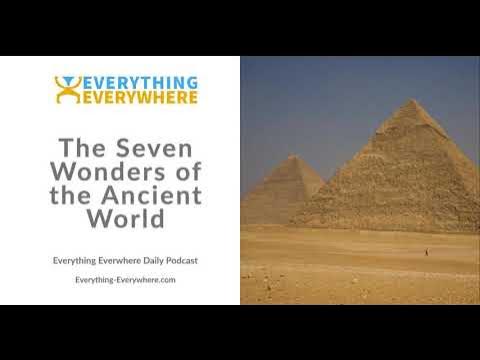Scientists Finally Explain How Pyramids Were Built
Summary
TLDRThe script explores the Great Pyramids of Giza, one of the original Seven Wonders of the World and the only one still standing. It delves into the purpose of the pyramids as a complex for Egyptian kings' afterlife, their construction with over 2 million limestone blocks, and the organization of the workers. It also touches on the Sphinx, the alignment of the pyramids with celestial bodies, and the ongoing mysteries of the interior structure and the missing treasures. The script concludes with modern efforts to uncover the pyramids' secrets using technology like robots and X-rays.
Takeaways
- 🏛️ The Great Pyramids of Giza are one of the original Seven Wonders of the World and the only one still existing today.
- 📜 The pyramids of Giza weren't the only pyramids; there were around a hundred of them in Egypt.
- 🔱 Ancient Egyptian kings were believed to become gods in the afterlife, necessitating elaborate burial complexes.
- 🔨 The Great Pyramid of Giza was constructed using over 2 million limestone blocks, each weighing around 2.5 tons.
- 👷 Around 25,000 workers contributed to the construction of the pyramids, and they were well-fed and housed.
- 🌌 The pyramids were aligned with amazing precision using two constellations, symbolizing the rays of the sun.
- 🦁 The Great Sphinx of Giza, with the head of Pharaoh Khafre, guarded the pyramid and was originally painted.
- 🚜 Limestone blocks were hauled from quarries using sleds, and ramps were likely used to position the stones.
- 💎 The pyramid's exterior was polished with sand and stone, and it featured a gold and silver capstone.
- 🔍 The interior of the Great Pyramid consists mostly of solid stone with a few chambers and many unexplored passages.
Q & A
What is the significance of the Great Pyramids of Giza?
-The Great Pyramids of Giza are considered one of the original Seven Wonders of the World and are the only ones that still exist today.
What were the pyramids in ancient Egypt believed to be used for?
-In ancient Egypt, pyramids were built to ensure that the king had everything they might need in the afterlife, including a tomb filled with furniture, food, gold, and other necessities.
How many pyramids were built in ancient Egypt?
-Overall, around one hundred pyramids were built in ancient Egypt, though some were not finished due to the lengthy construction time.
How many limestone blocks were used to build the Great Pyramid of Giza?
-Over 2 million limestone blocks were used to build the Great Pyramid of Giza, each weighing around 2.5 tons.
Who were the workers that built the pyramids?
-Contrary to popular belief, the workers were not enslaved people. They came from all over Egypt and were housed, well-fed, and lived more comfortably than the average Egyptian at the time.
How did ancient Egyptians align the pyramids without modern tools like compasses?
-Ancient Egyptians aligned the pyramids using two constellations, achieving remarkable precision in their construction.
What is the significance of the Sphinx near the Pyramid of Giza?
-The Sphinx, with the body of a lion and the head of Pharaoh Khafre, is considered a guardian of important areas and is one of the oldest and largest statues in the world.
What materials were used for the exterior and interior of the pyramids?
-The exterior of the pyramids was made of polished limestone blocks, while the interior used softer, fossil-lined yellow stone.
What construction methods might have been used to build the pyramids?
-Historians believe that a unique ramp system was used to move and place the massive stone blocks, with several ramps possibly surrounding or inside the pyramid.
What recent methods are scientists using to explore the pyramids?
-Scientists are using x-ray technology to scan the pyramids from the outside without going inside, trying to uncover the remaining mysteries of their construction and interior.
Why are there no hieroglyphs inside the pyramids?
-The interiors of the pyramids are mostly solid stone with very little open space and no hieroglyphs. Hieroglyphs can be found in the decorated tombs near the pyramids.
What was the purpose of the different chambers inside the pyramids?
-Different chambers were built inside the pyramids to ensure a burial chamber was always ready in case the pharaoh died before the construction was completed. The main chamber, called The King's chamber, was the final resting place for Pharaoh Khufu.
Outlines

Cette section est réservée aux utilisateurs payants. Améliorez votre compte pour accéder à cette section.
Améliorer maintenantMindmap

Cette section est réservée aux utilisateurs payants. Améliorez votre compte pour accéder à cette section.
Améliorer maintenantKeywords

Cette section est réservée aux utilisateurs payants. Améliorez votre compte pour accéder à cette section.
Améliorer maintenantHighlights

Cette section est réservée aux utilisateurs payants. Améliorez votre compte pour accéder à cette section.
Améliorer maintenantTranscripts

Cette section est réservée aux utilisateurs payants. Améliorez votre compte pour accéder à cette section.
Améliorer maintenantVoir Plus de Vidéos Connexes

Ilmuwan Akhirnya Menjelaskan Bagaimana Piramida Dibangun

The Seven Wonders of the Ancient World

The Seven Wonders of Ancient World - Ancient History - See U in History

Ternyata Ada Ruang Rahasia di Piramida Agung Selama Ini

What happened to the World Wonders?

Seven Wonders of the Ancient World - 3D DOCUMENTARY
5.0 / 5 (0 votes)
